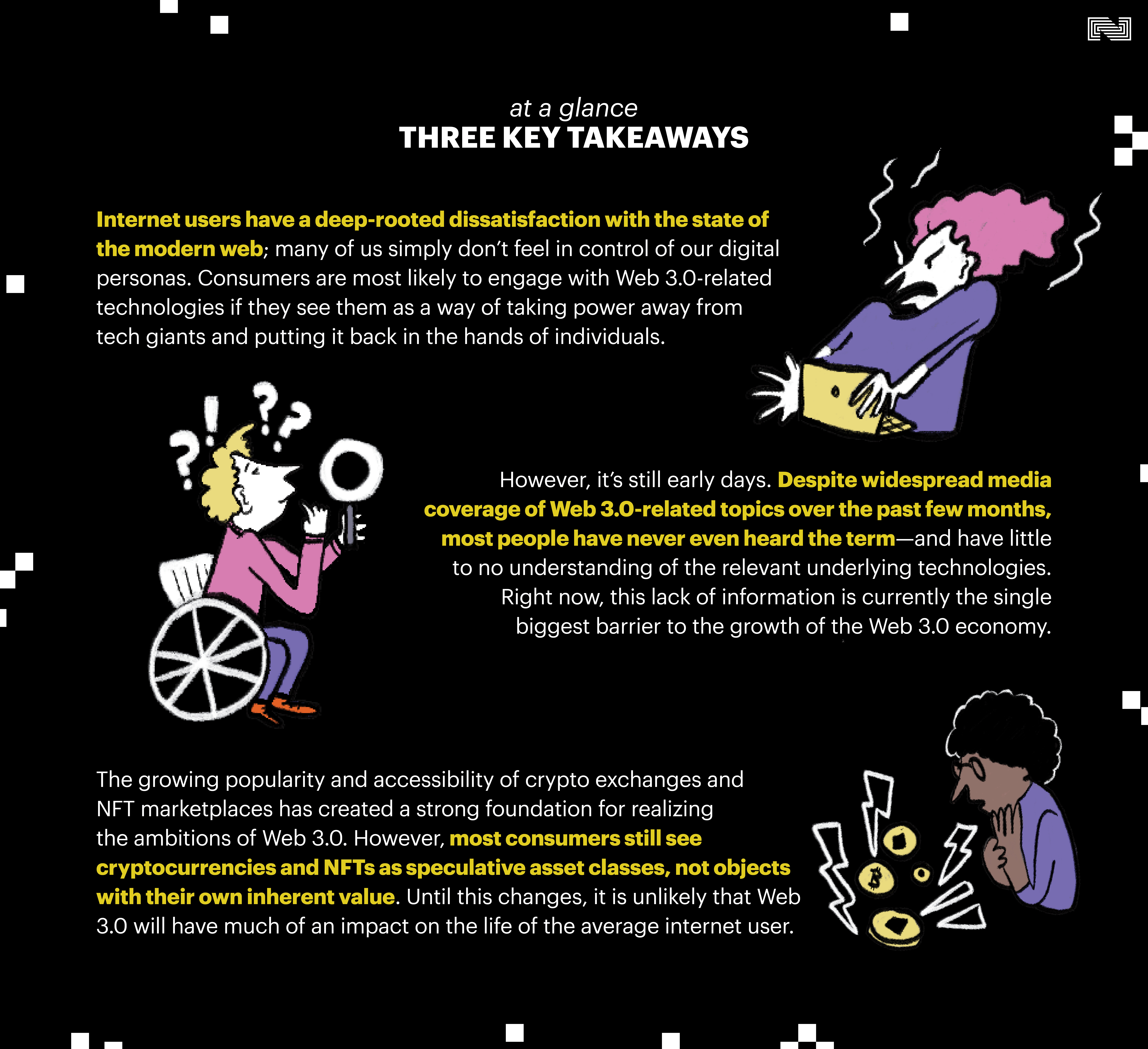Thought Leadership
Hitting the Mark Will This House Live in the Metaverse?
Welcome back to Hitting the Mark, my monthly analysis of developments at the intersection of business, marketing, and politics for modern C-Suite leaders. This month, I look at the metaverse in terms of how it can transform brands – and how it may transform society.
Before we vault to the future, I want to acknowledge the turmoil that the overturning of Roe v. Wade has caused. As predicted in last month’s column, this summer is “chock-full of potentially divisive issues for corporations.” At Stagwell, we moved immediately to provide a travel benefit that ensures all employees maintain access to reproductive healthcare. I worked for Planned Parenthood of New York as their consultant for 10 years in the late ’70s and ’80s when this legal battle was new – and feel strongly about protecting choice.
As you consider how to navigate this issue, our Harvard CAPS/Harris data shows that while most people would have supported continuing Roe, a majority would also have supported rollbacks to the viability standard as proposed by Justice Roberts, and large majorities oppose late-term abortions. The July edition of the Harvard CAPS/Harris Poll – released today – continues to track American sentiment post-Roe. If you’d like to connect for advice on how to navigate this landscape, please reach out.
Turning to the topic of this month’s newsletter, the metaverse. Today’s business leaders are faced with two major discussion tracks around the metaverse: how will it transform my brand? And how will it transform society?
The Metaverse and Brands
On the first: I had the pleasure earlier this June of giving a fierce argument on behalf of the future of the metaverse at the prestigious Oxford Union, alongside technologists, academics, journalists, and brand leaders seeking to determine whether “this house should live in the metaverse.” Spoiler alert: we lost the debate. But I got some interesting insights from the audience – mostly younger, Gen Z consumers. The reasons why we lost prove there’s much for marketers to dig in on as they drum up consumer excitement about the metaverse, map its contours, and start innovating their technologies, products, and services.
Younger consumers are cynical almost to the point of anger about Big Tech and FAANG dominating the metaverse. I heard impassioned speeches from the opposition about the various ailments Web2 platforms have unleashed on the world, from broken freedom of speech to harassment, to the consolidation of power, and more. And that tracks with recent research from National Research Group showing consumers think the Internet has become more commercialized (80%), addictive (79%), and has encouraged people to treat each other more cruelly (69%).
- My take: Big tech beware: if you look at the arc of innovation, tech empires have limited lifespans. Myspace fell to Facebook. YouTube is losing ground to TikTok. Facebook’s social empire based on the sale of user data is shrinking. In the metaverse, I believe Big Tech will certainly be part of the equation, but the hardware, servers, and aspects of the tools needed to build dominant visions of the metaverse and Web3 may push many new worlds and businesses into the market

These Oxfordians challenge the idea you can live a fulfilling life in the metaverse, even as they see the potential for it to scale and democratize access to global travel, quality education, and shared experiences. Blame it on the propensity of the young to see apocalypses lurking behind every corner or on the lingering psycho-social effects of the pandemic, but younger consumers are worried metaverse tech will open Pandora’s Box into a social dystopia where consumers live more in virtual reality than real life.
- My Take: What they ignore – and where brands have an opening to bridge this gap – is the sheer volume of time we already spend in digital and virtual realities. A reliance on digital existence is already a norm and could intensify, given more engaging and immersive metaverse worlds. This may actually lead to a more positive state of mental health in comparison to current screen time practices.
Oxford listeners are just as confused about the terminology as brand marketers (but that doesn’t matter). Metaverse? Web3? Blockchain? Younger consumers are just as baffled by the buzzwords as senior brand marketers. But they’re not invested in the halo excitement around this fresh new tech – and unimpressed with many of the early metaverse experiments which don’t model the true potential of Web3.
- My Take: The most helpful definition brands can work with is, the metaverse is not a single application, or program, or virtual reality – it’s, as Wired points out, a multiverse of metaverses. Like streaming services, there are many, constantly competing with other groups, constantly breaking into new content niches. While it may benefit technologists and investors to think of the metaverse in the context of cryptocurrency of NFTs, there is no necessary connection between the multiverse of metaverse and those terms. They are only part of the tech-bro world, along with unrelated ideologies. Your best bet as a brand playing in the metaverse over the next year? Think about it in the context of the experiences it can create, more so than the technology that needs to be built to reach its most perfect vision
The Metaverse and Society
Beyond pure brand applications, the metaverse promises to transform society for the better. There are four immediate Metaverse applications that illustrate the power of this technology – and why we’re bullish on ensuring it comes to life. The below is an excerpt from my speech at the Oxford Union.
Metaverse One: Avatar interviewing can massively increase women’s’ success in the job market.
Should we wait decades for attitudes to change or hope that implicit bias training will someday produce effective and lasting results? No. You are likely aware of the practice of blind auditions to select members of symphony orchestras.
In the past, candidates would perform before a selection committee on stage, where the gender of candidates was obvious. To combat likely gender bias, most American symphonies now conduct auditions with the performer behind a screen — only their music matters. The Guardian reported that the use of screens increases the odds that a woman will advance from preliminary rounds to finals by 50%! The percentage of women in American symphony orchestras has risen from 5% to nearly 30% in the period after screens were adopted.
Imagine if job interviews were gender-neutral. Interviewers would meet with identical avatars distinguished only by their answers to interview questions and the questions that prospective employers ask. The metaverse could create a level playing field in hiring unimaginable in today’s world. Millions of women are waiting for the metaverse to advance their careers.
Metaverse Two: The opportunity afforded by debate can reach thousands more. The Yale University high school tournament ordinarily brings 300 teams to its most heavily attended division of debate. In the Fall of 2020, 900 teams participated – three times as many when costs are reduced to a cell connection and a 4G cellphone, accessible to anyone for a small fraction of the cost of physical tournament attendance. Remarkably, by eliminating the expense of air travel, hotel stays, and local transportation, these efforts have significantly improved access for thousands of students. Are these events as moving, as satisfying, as physical attendance? Perhaps not, depending on how much you loathe the hassle, expense, and friction of travel, a virtual tournament has many advantages.
But, with a multiverse of 3D speakers, who can go to rounds, wander a virtual campus, gather at virtual cafes to discuss the resolution and complain about teammates and judges, the experience can be made both more satisfying and really, really cheap. By making debate more accessible to students everywhere the many lifelong advantages of this activity can reach hundreds of thousands of students who are denied access by the accidents of geography and economic status.
Metaverse Three: The metaverse can produce an explosion of educational opportunity. Zoom was a very taxing first step in distance learning. Let’s be clear: hours on a Zoom lecture can be mind-crippling. This explains the failure of Massive Open Online Classrooms – MOOCS – that enroll many and graduate almost no one because they are primarily cameras in lecture halls.
But the Metaverse is not your father’s Zoom technology. Within a metaverse environment with classmates around a table, with course materials available at a click to all within a classroom, everything can change. No one disputes that an immersive, high-resolution environment is greatly more engaging than Zoom. If a professor wants you to study the Great Pyramids at Giza, you can go there in photoreal environments. You can tour the tombs of Cheops and Tutankhamun in real time. You can examine exhibits at the Louvre without pushing through crowds of tourists. Lab experiments can be performed before your very eyes. It is true that a picture is worth a thousand words – but a lived experience is worth a thousand pictures.
Metaverse Four: Medical miracles. For example, the BBC tells the story of one British woman who recounted her joyous experience of visiting new worlds and environments after being left severely disabled by a traumatic brain injury. These interventions—priced only at the rapidly decreasing cost of a VR headset—have the potential to bring people immense benefits, ranging from stress relief, anxiety treatment, and amelioration of chronic pain.
Furthermore, such technology will dramatically improve surgical training, saving lives and limbs. One study finds that surgical trainees using VR learned a procedure nearly seven times faster than their traditionally trained counterparts; the technology helps to always keep surgeons’ focus on their patients rather than on external displays. Additionally, consulting doctors in virtual reality for minor ailments can help reduce strain on the already-overwhelmed medical industry.
We’ll be inventing and reinventing the metaverse for years, if not decades, to come. To make the metaverse perform for consumers (not just for those of us geeking out about the technology) brands are going to need to keep their ears to the ground with polling, surveys, and data analysis to track where consumers see the metaverse adding value – and where they’re just confused about why brands are serving virtual hot dogs.
Until next time,
Mark Penn
Related
Articles
In the News, Press Releases
Jul 09, 2025
STAGWELL LAUNCHES STAGWELL MEDIA PLATFORM (SMP), A CENTRALIZED TEAM OF GLOBAL MEDIA, TECHNOLOGY AND DATA INVESTMENT EXPERTS

In the News, Investments & Financials, Press Releases
Jul 08, 2025
Stagwell (STGW) Schedules Webcast to Discuss Financial Results for the Three Months Ended June 30, 2025

In the News, Investments & Financials, Press Releases, Talent & Awards
Jul 08, 2025
Stagwell (STGW) Advances Executive Team with Four Key Appointments





